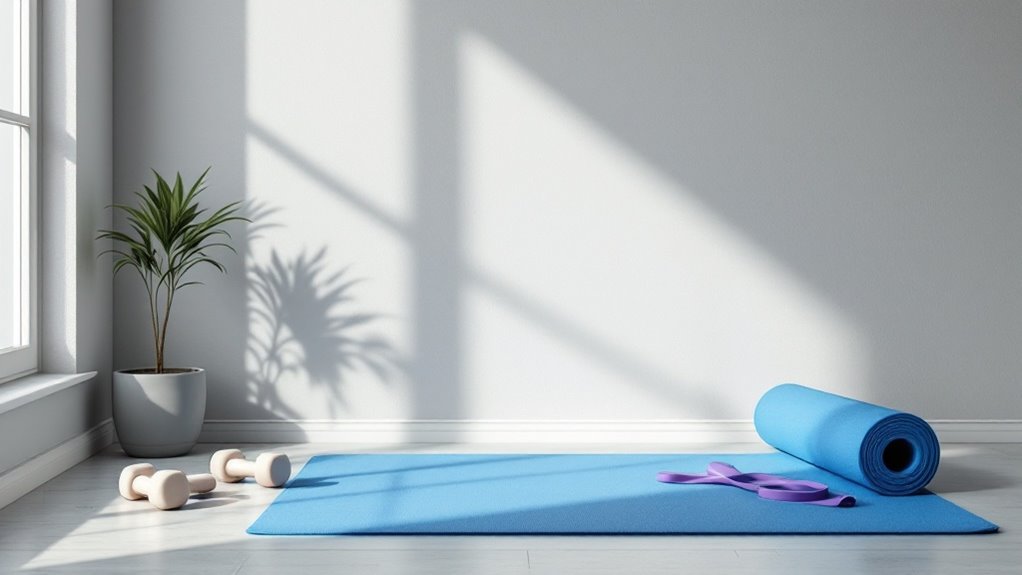Beginner Fitness Exercises

Beginners should start with foundational bodyweight exercises like squats, lunges, and glute bridges to build strength and proper form. A basic 15-30 minute circuit combining 3-4 exercises performed for 60 seconds each provides an effective full-body workout. Focus on mastering five fundamental movements: squatting, hinging, lunging, pushing, and pulling while maintaining proper breathing and positioning. Progressive overload principles guarantee continued improvement as strength and confidence grow. Let's explore how these movements translate to daily activities.
Key Takeaways
- Start with basic bodyweight exercises like squats, lunges, and glute bridges to build foundational strength without equipment.
- Master proper form through slow, controlled movements and focus on maintaining neutral spine alignment during exercises.
- Create a simple 15-30 minute circuit combining 3-4 exercises, performing each for 60 seconds with rest periods.
- Practice the five fundamental movements: squatting, hinging, lunging, pushing, and pulling for everyday functional fitness.
- Begin with modified versions of exercises and gradually increase intensity as form and strength improve.
Essential Body-Weight Exercises for Beginners

When starting a fitness journey, mastering fundamental bodyweight exercises provides the vital foundation for building strength, stability, and proper form.
The bodyweight squat stands as a cornerstone movement, targeting multiple muscle groups while teaching proper knee positioning. Practicing with tempo variations, like a 4-count descent, helps develop control and prevent injury. No equipment required makes these exercises accessible to everyone, regardless of gym access. Maintaining straight back during squats ensures proper form and prevents injuries.
Master the fundamentals first: a slow bodyweight squat builds strength and teaches proper form for safer, more effective training.
Reverse lunges build single-leg strength and balance, with jump variations available for progression. Core strength training helps improve posture and reduce the risk of back injuries during daily activities.
The glute bridge rounds out these essentials by activating posterior chain muscles, particularly the glutes and hamstrings, with single-leg options for advanced training.
These movements establish critical movement patterns for long-term fitness success.
Building Your First Workout Circuit

Building an effective workout circuit demands strategic planning and proper exercise selection to enhance results while preventing burnout. A well-designed circuit combines strength and cardio elements while alternating between muscle groups to maintain intensity. Research shows that 15-30 minute circuits can effectively build muscle and burn calories simultaneously. Starting with low intensity and gradually increasing difficulty helps prevent discouragement and injury risk. Focusing on progressive overload helps ensure continued strength gains as your fitness improves.
- Start with 3-4 foundational exercises like squats, push-ups, and glute bridges.
- Perform each exercise for 60 seconds with 15-30 seconds rest between stations.
- Begin with 15-minute sessions, focusing on proper form and controlled movements.
- Alternate between upper and lower body exercises to promote recovery.
- Incorporate dynamic movements like jumping jacks to maintain heightened heart rate.
The key is starting simple and gradually increasing complexity as fitness improves.
Safe Training Techniques and Form

Safe training techniques form the bedrock of any successful fitness journey, protecting beginners from common injuries while maximizing their workout effectiveness.
Proper form starts with maintaining neutral spine orientation and correct posture throughout exercises, ensuring joints stay properly positioned during movements. Kinetic chain checkpoints must be monitored carefully during each exercise to ensure optimal alignment and prevent injury.
Controlled execution is essential, emphasizing slow, intentional movements with minimal momentum.
Breathing patterns play a significant role – exhaling during exertion and inhaling during recovery phases while maintaining core involvement.
For safety, beginners should start with modified exercises, using lighter weights and supported movements until proper form is mastered.
Proper risk assessment helps determine appropriate workout intensities and movement progressions for each individual's fitness level.
The compound movements emphasized in strength training programs provide an efficient foundation for developing proper form and functional strength.
Mastering Basic Movement Patterns

Five fundamental movement patterns form the foundation of functional fitness and daily activities.
These essential movements – squatting, hinging, lunging, pushing, and pulling – translate directly into real-world capabilities and improved quality of life.
- Master the squat to maintain independence in standing from chairs and benches.
- Perfect the hip hinge to protect your back when lifting objects.
- Practice lunges to build stability for maneuvering stairs confidently.
- Develop pushing strength for overhead reaching and door opening.
- Build pulling power for carrying groceries and managing daily loads.
The evolution of fitness training has shifted from isolated muscle work to functional training that better serves practical movement needs.
Following progressive overload principles ensures continuous improvement in these foundational movements.
These patterns, when properly executed, create a strong foundation for both exercise progression and everyday movement competence. Regular practice of these movements helps develop new neural pathways through proper muscle coordination.
Frequently Asked Questions
How Long Should I Rest Between Workouts as a Beginner?
Beginners should rest 48-72 hours between workouts targeting the same muscle groups. This allows proper muscle recovery and adaptation to new training stimuli.
Following a Monday-Wednesday-Friday split creates ideal recovery windows while maintaining consistent training momentum.
More advanced lifters may adjust this timeline, but newcomers benefit from this structured approach to prevent overtraining and optimize gains.
What Should I Eat Before and After My Workout Sessions?
Like a race car needs the right fuel mix before hitting the track, workout nutrition requires precise timing.
Pre-workout, consume easily digestible carbs and protein 1-2 hours before exercise – fruits, pretzels, or Greek yogurt work well.
Post-workout, aim for 40-60g carbs and 20-30g protein within 30-60 minutes – options include whey protein shakes, turkey, or chicken with sweet potatoes to optimize recovery and results.
Is It Better to Exercise in the Morning or Evening?
Both morning and evening workouts offer distinct advantages.
Morning exercise kickstarts metabolism, improves all-day energy levels, and promotes better sleep patterns.
Evening workouts capitalize on peak body temperature and muscle performance, making them ideal for strength training.
The best time ultimately relies on individual schedules, consistency potential, and personal energy patterns.
The key is selecting a time that becomes sustainable long-term.
How Do I Stay Motivated When I Don't See Immediate Results?
Studies show that 73% of people abandon fitness goals due to lack of visible progress in the first month.
Staying motivated requires adjusting focus from immediate results to daily wins and habit formation. Track non-scale victories like increased energy and strength gains, set realistic micro-goals, and celebrate small achievements.
Building intrinsic motivation through activity enjoyment and community support creates sustainable long-term progress.
Should I Take Supplements When Starting a New Fitness Routine?
A new fitness routine should prioritize proper nutrition through whole foods before considering supplements.
While supplements like creatine and protein powder can support progress, they're not magic solutions.
Beginners should focus on establishing consistent workout habits and balanced eating first.
If choosing supplements, start with basics like creatine or protein powder, and always consult healthcare professionals before adding new supplements to the routine.
Final Thoughts
Like seeds planted in fertile soil, these fundamental fitness exercises lay the groundwork for a stronger, healthier future. By mastering proper form, understanding basic movement patterns, and gradually building effective circuits, beginners create a solid foundation for their fitness journey. Through consistent practice and dedication to proper technique, newcomers can transform these simple bodyweight movements into powerful tools for lasting physical development.


